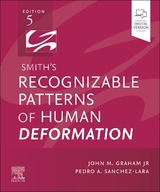
Smith's Recognizable Patterns of Human Deformation
Elsevier - Health Sciences Division (Verlag)
978-0-323-29494-2 (ISBN)
- Titel erscheint in neuer Auflage
- Artikel merken
Examines the initial clinical approach to suspected deformation problems, and then walks you through pathogenesis, diagnostic features, management, prognosis, and counseling for each condition.
Addresses a full range of lower extremity deformations; joint dislocations; nerve palsies; chest and spinal deformations; head and neck deformations; craniosynostosis and cranial bone variations; problems associated with abnormal birth presentation, birth palsies, and procedure-related defects; infant head shape variations; and torticollis.
Distinguish deformations from malformations for appropriate management.
Each chapter utilizes four consistent sections - Genesis, Features, Management and Prognosis, and Differential Diagnosis - to provide concise yet comprehensive information on 50 common pediatric conditions. These chapters are available for individual purchase or download to serve as educational guides for parents regarding evidence-based management of these conditions.
Diagnosis and management of common pediatric orthopedic conditions is covered in detail.
Updated discussion of Sudden Infant Death Syndrome brings a new focus to the important topic of infant sleeping environments.
New before-and-after illustrations and detailed discussions focus on cranial-orthotic molding helmets and the surgical correction of craniosynostosis.
Provides evidence-based management recommendations on common fetal complications such as oligohydramnios, pulmonary hypoplasia, and uterine structural abnormalities, and discusses current management techniques for each.
Selected references at the end of each chapter provide further recent information regarding each of these topics.
Offers essential information to a range of professionals, including neonatologists, pediatricians, family practitioners, nurses, physical and occupational therapists, rehabilitative specialists, pediatric nurse practitioners, and residents in all fields.
Expert Consult eBook version included with purchase. This enhanced eBook experience allows you to search all of the text, figures, and references in the book on a variety of devices.
John Graham, MD, is a pediatrician and medical geneticist with more than 35 years of training and experience in clinical genetics, dysmorphology, teratology, developmental disabilities, communicative disorders and public health aspects of birth defects. He holds a lifetime appointment as a professor of Pediatrics emeritus at UCLA School of Medicine, where he is on the executive committee of the UCLA Intercampus Medical Genetics Training Program. Graham continues to treat patients at Cedars-Sinai and Harbor-UCLA Medical Center. Specialist in Medical Genetics and Pediatrics. Medical School at UCLA School of Medicine and Fellowship: Cedars-Sinai
Section 1 Introduction
1. Clinical Approach to Deformation Problems: Malformations, Deformations, Disruptions, and Dysplasias
Section 2 Patterns Of Deformation
2. Foot Deformations: Foot Contractures, Positional Foot Abnormalities
3. Calcaneovalgus (Pes Planus)
4. Metatarsus Adductus (Metatarsus Varus)
5. Talipes Equinovarus (Clubfoot)
6. Deformed Toes
7. Flexible Flatfoot
Section 3 Other Lower Extremity Deformations
8. Tibial Torsion
9. Femoral Anteversion
Section 4 Joint Dislocations
10. Joint Dislocation
11. Developmental Dysplasia of the Hip (Congenital Dislocation of the Hip)
12. Knee Dislocation (Genu Recurvatum)
13. Dislocation of the Radial Head
Section 5 Neurapraxias (Palsies)
14. Facial Palsy
15. Brachial Plexus Palsy
16. Diaphragmatic Paralysis: Diaphragmatic Eventration
17. Other Peripheral Nerve Palsies
Section 6 Thoracic Cage and Spinal Deformations
18. Lung Hypoplasia
19. Pectus Excavatum and Pectus Carinatum
20. Scoliosis
Section 7 Head and Neck Deformations
21. Nose Deformation
22. External Ears
23. Mandibular Deformation
24. Congenital Muscular Torticollis
25. Torticollis-Plagiocephaly Deformation Sequence: Nonsynostotic or Positional Plagiocephaly
26. Infant Sleeping Position and Sudden Infant Death Syndrome
27. Positional Brachycephaly
28. Other Postnatal Head Deformations
Section 8 Craniosynostosis
29. Craniosynostosis: General
30. Sagittal Craniosynostosis
31. Coronal Craniosynostosis
32. Metopic Craniosynostosis
33. Lambdoidal Craniosynostosis
34. Multiple Sutural Craniosynostosis
Section 9 Cranial Bone Variations
35. Vertex Birth Molding
36. Vertex Craniotabes
37. Anterior Fontanelle Bone
38. Parietal Foramina
39. Aplasia Cutis Congenita: Scalp Vertex Cutis Aplasia, Temporal Triangular Alopecia
40. Cephalohematoma
41. Wormian Bones
Section 10 Abnormal Birth Presentation
42. Breech Presentation Deformation
43. Transverse Lie Deformation
44. Face and Brow Presentation Deformation
Section 11 Whole-Body Deformation Or Disruption
45. Small Uterine Cavity Deformation: Bicornuate or Myomatous Uterus
46. Oligohydramnios Sequence
47. Fetal Akinesia Deformation Sequence
48. Abdominal Pregnancy (Extrauterine Pregnancy)
49. Early Embryonic Compression or Disruption
50. Obstetric Procedure-Related Defects
Section 12 Mechanics In Morphogenesis
51. Principles of Human Biomechanics
| Erscheint lt. Verlag | 10.10.2015 |
|---|---|
| Verlagsort | Philadelphia |
| Sprache | englisch |
| Maße | 184 x 260 mm |
| Gewicht | 1180 g |
| Themenwelt | Medizin / Pharmazie ► Medizinische Fachgebiete ► Orthopädie |
| Medizin / Pharmazie ► Medizinische Fachgebiete ► Pädiatrie | |
| Studium ► 1. Studienabschnitt (Vorklinik) ► Histologie / Embryologie | |
| ISBN-10 | 0-323-29494-4 / 0323294944 |
| ISBN-13 | 978-0-323-29494-2 / 9780323294942 |
| Zustand | Neuware |
| Haben Sie eine Frage zum Produkt? |
aus dem Bereich



